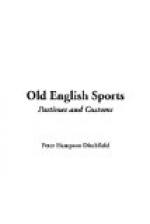Great skill and perseverance were required in training these birds. When they were not flying after their prey, they were hoodwinked, i.e. their heads were covered with caps, which were often finely embroidered. On their legs they had strings of leather, called jesses, with rings attached. When a hawk was being trained, a long thread was fastened to these rings to draw the bird back again, but when it was well educated, it would obey the voice of the falconer and return when it had performed its flight. It was necessary for the bird to know its master very intimately, so a devoted follower of the sport would always carry his hawk about with him, and the two were as inseparable as a Highland shepherd and his dog. The sportsman would feed his bird and train it daily, and in an old book of directions he is advised “at night to go to the mews, and take it from its perch, and set it on his fist, and bear it all the night,” in order to be ready for the morrow’s sport.
[Illustration: A FALCONER.]
The mews were the buildings where the hawks were kept when moulting, the word “mew” being a term used by falconers to signify to moult, or cast feathers; and the King’s Mews, near Charing Cross, was the place where the royal hawks were kept. This place was afterwards enlarged, and converted into stables for horses; but the old name remained, and now most stables in London are called mews, although the word is derived from falconry, and the hawks have long since flown away.
The sport declined at the end of the seventeenth century, when shooting with guns became general, but our language has preserved some traces of this ancient pastime. When a person is blinded by deceit, he is said to be “hoodwinked,” and this word is derived from the custom of placing a hood over the hawk’s eyes before it was released from restraint.
On the Feast of St. Michael, or Michaelmas, the tenants were in the habit of bringing presents of a fat goose to their landlord, in order to make him kind and lenient in the matters of rent, repairs, and the renewal of leases, and the noble landlords used to entertain their tenants right royally in the great halls of their ancestral mansions, roast goose forming a standing dish of the repast. This is probably the origin of the custom which prevails at the present time of eating geese at Michaelmas.
When the harvest was over, and the farmers were not so busy, they often amused themselves by the cruel sport of baiting a bull. An old gentleman who lived at Wokingham was so fond of this savage pastime that he left in his will a sum of money for the purpose of providing every year two bulls to be baited for the amusement of the people of his native town. The bulls are still bought, but they are put to death in a more merciful manner, and the meat given to the poor. Amongst the hills in Yorkshire there is a small village, through which a brook runs, crossed by two bridges, and having a stone wall on each side. Thus, when the bridges were stopped up, there was formed a wall-encircled space, into which, once a year, at least, a poor bull was placed, to be worried to death by dogs, and within the memory of men now living this cruel sport has been carried on.




